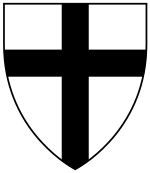


The Battle of Swiecino -1462
The Battle of Świecino (named for the
village of Świecino, near Żarnowiec Lake, northern Poland) also called the Battle of Żarnowiec
or in German Die Schlacht bei Schwetz, took place on September 17, 1462 during the Thirteen
Years' War. The Polish forces, commanded by Piotr Dunin and consisting of some 2,000 mercenaries and Poles, decisively
defeated the 2,700-man army of the Teutonic Knights, commanded by Fritz
Raweneck and Kaspar Nostyc. Auxiliary forces sent by duke Eric II
of Pomerania, temporary ally of the Teutonic Knights, did not enter the battle. The Polish forces consisted mostly
of the mercenaries hired by the Polish king, Casimir IV the Jagiellon and the city of Danzig
(Gdańsk). This army included 1000 cavalry, of which 112 were heavy cavalry, and another 1000 of infantry. 1000 cavalry
and 400 infantry were mercenaries hired by Polish king, while the rest were units from Danzig (Gdańsk). Most of the Teutonic army, under the command of Fritz
Raweneck and Kaspar Nostyc, were troops gathered from the nearby castles Mewe (Gniew), Stargard (Starogard Gdański),
Nowe, Skarszewy and Stara Kiszewa. This army totalled 1000 cavalry and 400 infantry. Raweneck also had the supply chain (tabors), cannons and up to 1300 auxiliary infantry of Pomeranian peasants, used mainly for fortification
works.
The Battle
The battle started in the evening. Adopting a relatively new tactic, Polish units built a fortified camp on the
Hussite model consisting of wagons linked by a chain surrounded by a deep ditch (tabor).
The units of Raveneck and his subordinate, Kaspar Nostyc (commander from Conitz (Chojnice) also created a tabor. Piotr Dunin
decided not to wait for the enemy and attacked first, setting infantry with crossbows on the left, defended by cavalry between
the tabor and the coast of the nearby lake of Rogoźnica. Raveneck placed cavalry in front of his tabor, and infantry
behind it, without any strategic plan. The first phase of the battle was started by a charge of Polish heavy cavalry under
Paweł Jasieński. Fierce fighting continued for three hours and ended without a clear
winner. After a short pause at midday, Teutonic units were able to push the Poles back; however, they found themselves under
very heavy fire from crossbows of the Polish infantry, which caused huge losses and a withdrawal. During this fight Raveneck
was wounded. He stopped his soldiers and tried to attack again, but this charge ended with a total defeat - Raveneck died
and the rest of the cavalry surrendered or escaped. The Teutonic infantry tried to defend themselves at the tabor but its
resistance was broken by a quick attack of Polish cavalry. At the end of the battle, reinforcements of Eric II of Pomerania
appeared, however, seeing the defeat of the Teutonic Knights, the Pomeranian prince did not attack, while the Poles attacked,
forcing his troops to flee.
The Teutonic Order's army lost around 1000 soldiers, including some 300 cavalrymen. Fifty soldiers
were captured. The Teutonic commander was also killed in battle and was buried in the Żarnowiec chapter church. The
Poles lost just 100 soldiers, although 150 later died from their wounds. Among the dead on the Polish side was Maciej
Hagen from Gdańsk. Piotr Dunin was wounded twice. The direct
result of the battle of Świecino was that the city of Danzig and Pomerania were freed from the danger of an attack by
the Teutonic Order. As a result, the royal and municipal armed forces could be used elsewhere in the war, mainly to protect
the Vistula waterway and to capture the Teutonic held strongholds. This way that Teutonic forces in Prussia on the right
bank of Vistula were cut off from supplies from Western Europe. The psychological significance of the battle was that this
was the first open field battle won by the royal forces, so it increased the morale of the Polish forces and lowered the
morale of the Teutonic Knights. Many military historians say that the battle of Świecino was the turning point of the
Thirteen Years' War, leading to the final Polish victory in 1466.
